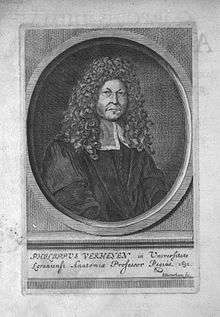Philip Verheyen

_(14778759294).jpg)
Philip Verheyen (April 23, 1648 – January 28, 1710) was a Flemish surgeon, anatomist and author.
As the third child of seven, Philip Verheyen was born in Verrebroek, in modern Belgium,[1] (most likely in his parents' house, standing on a small plot of owned land in the area called "Borring", close to the border with Meerdonk) to Thomas Verheyen and Joanna Goeman. He was baptized in the parish church of Verrebroek on the 24th of April 1648. Little is known of his childhood. As a young boy he was probably a cowherd and it is assumed that he learned to read and write at the local parish school. Local folk tales claim that he had such a brilliant memory that he could recite the pastor's sermon after attending mass on Sunday.
The pastor of the village took him under his wing and he was sent to Leuven in 1672 where he spent three years at Trinity College.[2]
Concluding his studies in the liberal arts in 1675 Verheyen went on to study theology with the intention of following in the footsteps of his mentor and joining the clergy to become a priest. It was at this crucial juncture that an illness resulted in the amputation of his left leg rendering him unfit for the clergy. This event proved to be of utmost importance to the subsequent path he chose.[3]
Embarking on a career in medicine, he initially continued at Trinity College and from 1681 to 1683 studied in Leiden. He returned to Leuven in 1683, obtaining the doctorate in medicine there. He gave lessons in anatomy and surgery and also practiced medicine. As a result of his many publications, in a short period of time he acquired renown both in and outside the country.[3] The year 1693 saw the first publication of his Corporis Humani Anatomia.
Philippe Verheyen died in November 1710 and was buried in the churchyard of the church of St Michael in Leuven. Prior to his death, he had given orders for his body to be buried outside the church so as not to infect the building with "unwholesome vapours".[4]
In 1862 his native village held a celebration of his life and achievements.[5]
References
- ↑ Suy, R. (2007). "Philip Verheyen (1648-1710) and his Corporis Humani Anatomiae" (PDF). Acta Chir Belg. Retrieved 28 January 2015.
- ↑ Pollier-Green, Pascale (2008). Confronting Mortality with Art and Science. Asp. p. 76.
- 1 2 LINDEBOOM, Dutch medical biography, p. 2046
- ↑ Emory, John (1831). The Works of the Reverend John Wesley, A. M. Methodist Episcopal Church. p. 583.
- ↑ HOORNAERT, Philip Verheyens verheerlijking (1863), p. 15
External links
| Wikimedia Commons has media related to Philip Verheyen. |
- A modern art project has been based on a fictionalised biography of Verheyen which has him dissecting his own amputated leg: http://sreshtaritpremnath.com/philip-verheyen-project. This has no basis in history.
- In 2005 a 15 min. short video was produced by Van Glabbeek, Francis (UZA-UA) & Daenens, Hedwige: http://www.stuiter.be/index.php/en/projects/philip-verheyen
- In 2010 a new 30 min. documentary was made as a coproduction with the "Working Group VERHEYEN 2010", directed by Hedwige Daenens (DigitalStories): http://www.stuiter.be/index.php/nl/projecten/philip-verheyen